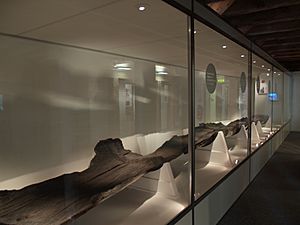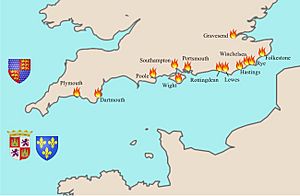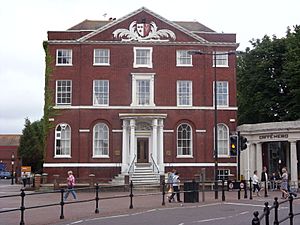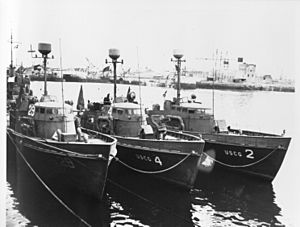History of Poole facts for kids
Poole is a town in Dorset, England, with a long and interesting past. Its story began thousands of years ago, when people first settled around Poole Harbour during the Iron Age. The town we know today grew on a small piece of land sticking out into the northern part of the harbour. Poole quickly became a very important port after the Norman Conquest of England, which helped it grow even more.
Contents
What's in a Name? The Story of Poole's Name
The name Poole comes from old English words. Pool meant a place near a pool or a small river. Pol was used for people who lived near a small body of water. Over time, the name has been spelled in different ways, like Pool, Pole, and Polle.
Poole's Earliest Settlers: The Iron Age and Romans
People have lived around Poole Harbour for at least 2,500 years. During the Iron Age, a Celtic group called the Durotriges lived in Dorset. They moved from hill forts like Maiden Castle to lower areas near the River Frome and Poole Harbour. This marshy area might have given them their name, which means "water dwellers."
The Durotriges traded across the English Channel with the Veneti, a sea-faring tribe from France. An amazing discovery in the harbour is the Poole Logboat. This boat is 10 meters (33 feet) long and was made from a single oak tree. It is over 2,000 years old! Back then, the harbour was not as deep, so any early settlements are now underwater.
Roman Arrival and Hamworthy
Poole was one of the places where the Romans landed when they conquered Britain. This happened in the 1st century AD. The Roman Emperor, Vespasian, brought his army, the Second Augustan Legion, to the harbour in 43 AD. They set up a settlement called Hamworthy, which is just west of Poole's modern town centre. The Romans continued to use the harbour throughout their time in Britain.
Poole in the Middle Ages: Growth and Challenges
After the Saxons took over southwestern Britain in the 7th century, Poole became part of the Kingdom of Wessex. Poole was a good spot for fishing and a safe place for ships to stop. It was on the way to Wareham, an important Saxon town.
Viking Attacks and Royal Charters
In 876, a Danish Viking army captured Wareham. But Alfred the Great and his Saxon army defeated them. The Danish fleet tried to escape through Poole Harbour, but a big storm sank most of their ships. The Danes returned in 1015 under Canute the Great. He used Poole Harbour as a base to attack the areas around Wessex.
Poole stayed a small fishing town until the Norman Conquest. In the 12th and 13th centuries, Poole's sea trade and fishing grew. Wareham became less important. In 1248, the Lord of the Manor, Sir William Longspee, sold a special document called a charter to the people of Poole. He needed money for a religious war called the Seventh Crusade.
This charter gave Poole important rights. The town could choose its own mayor and hold its own court. It also meant Poole did not have to pay certain taxes on goods.
French Attacks and Wool Trade
In 1405, a French and Spanish navy attacked Poole. They burned and looted much of the town. This was revenge for a Poole captain named Henry Paye. He was a privateer, meaning he was allowed by the English king to attack enemy ships. Paye often raided French and Spanish ships along the coast.
Despite this attack, Poole kept growing. It became the biggest port in Dorset. In 1433, King Henry VI made Poole a "Port of the Staple." This meant Poole could trade wool, which was very profitable. This status also allowed Poole to build defenses. A wall, a ditch, and a stone gatehouse were built on the north side of the town.
Early Modern Poole: Wars and Trade
The English Civil War
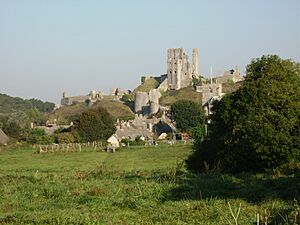
During the English Civil War, Poole strongly supported the Parliament. It was a Parliamentary stronghold in Dorset, which was mostly loyal to the King. Nearby, Wimborne and the Bankes family at Corfe Castle supported King Charles. Poole was often threatened, but it remained strong for Oliver Cromwell until the war ended.
In 1646, the Royalists were losing. The Parliamentary army from Poole attacked Corfe Castle. Dame Mary Bankes led the castle's defense. She had successfully defended it before in 1643. She might have won again, but one of her men, Colonel Pitman, betrayed her. Parliament ordered the castle to be destroyed so it could not be used by the Royalists again. But because of Dame Mary's bravery, the attackers gave her the castle keys. These keys are now on display at Kingston Lacy. When the King returned to power, King Charles II ordered Poole's defenses to be torn down.
Independence and Newfoundland Trade
Poole continued to grow, even with problems like piracy. In 1568, Queen Elizabeth I gave Poole more independence from Dorset. It became a "county corporate," meaning it had its own local government. It was called 'the County of the Town of Poole' until the 18th century.
Poole also started successful trade with the North American colonies. This included important fisheries in Newfoundland. By the mid-16th century, Poole was bringing in lots of salt. Salt was key for drying and preserving cod fish. This "salt cod" trade grew to meet the demand for fish in Catholic countries in Europe.
Poole's most successful period of trade was from the early 18th to the early 19th century. Ships would sail from Poole to Newfoundland with salt and supplies. They would catch, dry, and salt the fish in Newfoundland. Then, they would take the fish to ports in Spain, Portugal, and Italy. Finally, the ships would return to Poole with wine, olive oil, and dried fruits.
Modern Poole: Industry, Tourism, and Change
In the early 18th century, Poole had more ships trading with North America than any other English port. This brought huge wealth to Poole's merchants. This money helped build many of the grand Georgian houses you can still see in the Old Town near the Quay. Examples include Sir Peter Thompson's mansion from 1746 and Beech Hurst, built in 1789.
Decline in Trade and New Industries
The end of the Napoleonic Wars in 1814 and the War of 1812 changed things for Poole's merchants. With peace, French and American ships could fish and offer services more cheaply. This caused a quick decline in trade, and most merchants stopped trading within a few years.
Poole grew fast during the industrial revolution. More people moved to towns. Poole became a place of both wealth and crowded poverty. At the start of the 19th century, nine out of ten workers in Poole worked in harbour jobs. But as the century went on, ships became too big for the shallow harbour. Poole started losing business to deeper ports like Liverpool and Southampton.
In 1847, Poole's first railway station opened in Hamworthy. It later extended to the town centre in 1872. This largely ended the port's busy coastal shipping trade. The Royal National Lifeboat Institution (RNLI) placed a lifeboat at Sandbanks in 1865. The crew had to travel by horse-drawn carriage from Poole High Street. So, in 1882, it moved to a new station at Fisherman's Dock on Poole Quay.
Tourism and Marconi's Experiments
During the 19th century, the beaches and scenery of southern Dorset began to attract tourists. Villages east of Poole grew and merged, forming the popular seaside resort of Bournemouth. Poole itself did not become a resort. However, it continued to grow because Bournemouth's rapid expansion created a big demand for goods made in Poole.
In 1897, the Haven Hotel in Poole was used for some of Marconi's wireless experiments. Marconi was able to receive radio signals in Poole that were sent from Alum Bay, Isle of Wight, 32 kilometers (20 miles) away.
Poole in the 20th Century: War and Renewal
World War II and D-Day
Poole was the third largest starting point for the D-Day landings of Operation Overlord in World War II. After D-Day, it became a base for sending supplies to the allied forces in Europe. Eighty-one landing craft carrying US Army troops left Poole Harbour for Omaha Beach in France.
Poole was also important for developing "Combined Operations" (working together on land, sea, and air). It was the base for the US Coast Guard's 'Rescue Flotilla One'. This group had 60 small ships called cutters. These cutters patrolled the D-Day invasion areas. A US Coast Guard officer is buried at St James' Church. A plaque on the quayside honors the cutters' departure for the Normandy Invasion and thanks the people of Poole.
Post-War Redevelopment
Many of Poole's buildings were bombed during World War II. Years of neglect followed due to economic problems. Major renewal projects started across the town in the 1960s. Many old, rundown properties were pulled down. They were replaced with modern public housing. Poole General Hospital was built in 1969. A large indoor shopping centre, the Arndale Centre (now the Dolphin Centre), also opened that year.
Sadly, many of Poole's historic buildings were also destroyed during this time. To protect what was left, a 15-acre (6 hectare) Conservation Area was created in Poole Town Centre in 1975. The RNLI moved its main office from London to Poole in 1974. The lifeboat station at Fisherman's Dock closed to become a museum. The lifeboat operated from a new station at Lilliput Marina until 1989. Then, it moved to a new site on Poole Quay by Poole Bridge.
In 1988, there was a chemical explosion in Poole. About 3,500 people had to leave the town centre. This was the biggest peacetime evacuation in the country since World War II.
Recent Changes and Administration
Building projects in recent years include tearing down the Hamworthy power station in the early 1990s. The old gas works area was also redeveloped. This area is now part of the Poole Quarter, a housing project near the town centre with 512 new homes. Other projects include the renovated Lighthouse arts centre, Baiter Park, and the new Royal National Lifeboat Institution headquarters. In 2007, Poole received an award for its construction work.
Poole was managed by Dorset County Council until 1997. After that, it became a "unitary authority" under Poole Borough Council. This meant it managed its own local services. In 2019, Poole became part of the larger Bournemouth, Christchurch and Poole unitary authority area.


